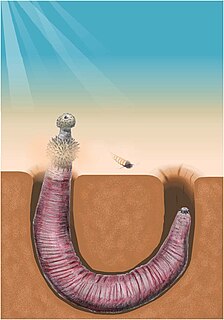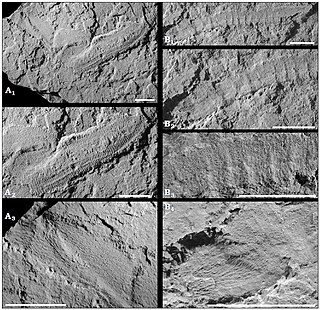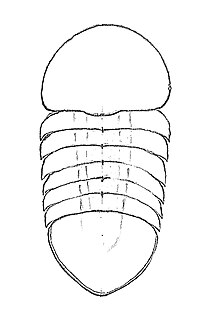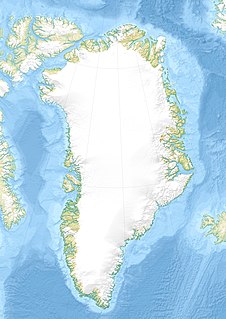
The Polychaeta, also known as the bristle worms or polychaetes, are a paraphyletic class of annelid worms, generally marine. Each body segment has a pair of fleshy protrusions called parapodia that bear many bristles, called chaetae, which are made of chitin. More than 10,000 species are described in this class. Common representatives include the lugworm and the sandworm or clam worm Alitta.

Opabinia regalis is an extinct, stem group arthropod found in the Middle Cambrian Burgess Shale Lagerstätte of British Columbia. Opabinia was a soft-bodied animal, measuring up to 7 cm in body length, and its segmented trunk had flaps along the sides and a fan-shaped tail. The head shows unusual features: five eyes, a mouth under the head and facing backwards, and a clawed proboscis that probably passed food to the mouth. Opabinia probably lived on the seafloor, using the proboscis to seek out small, soft food. Fewer than twenty good specimens have been described; 3 specimens of Opabinia are known from the Greater Phyllopod bed, where they constitute less than 0.1% of the community.

Sirius Passet is a Cambrian Lagerstätte in Greenland. The Sirius Passet Lagerstätte was named after the Sirius sledge patrol that operates in North Greenland. It comprises six places in Nansen Land, on the east shore of J.P. Koch Fjord in the far north of Greenland. It was discovered in 1984 by A. Higgins of the Geological Survey of Greenland. A preliminary account was published by Simon Conway Morris and others in 1987 and expeditions led by J. S. Peel and Conway Morris have returned to the site several times between 1989 and the present. A field collection of perhaps 10,000 fossil specimens has been amassed. It is a part of the Buen Formation.

The Emu Bay Shale is a geological formation in Emu Bay, South Australia, containing a major Konservat-Lagerstätte. It is one of two in the world containing Redlichiidan trilobites. The Emu Bay Shale is dated as Cambrian Series 2, Stage 4, correlated with the upper Botomian Stage of the Lower Cambrian.
A number of assemblages bear fossil assemblages similar in character to that of the Burgess Shale. While many are also preserved in a similar fashion to the Burgess Shale, the term "Burgess Shale-type fauna" covers assemblages based on taxonomic criteria only.
Chuandianella ovata is an extinct shrimp-like stem group crustacean that lived during the Atdabanian Age of the Early Cambrian. It is the only species classified under the genus Chuandianella of the family Waptiidae. Its fossils were recovered from the Chengjiang Lagerstätte of the Maotianshan Shales in China.

Isoxys is a genus of extinct, pelagic bivalved arthropod; the various species may have been roam-swimming predators. It had a pair of large spherical eyes, and two large appendages It is possible that these appendages are homologous to the great appendages of radiodonts and megacheirans.

Archaeopriapulida is a group of priapulid-like worms known from Cambrian lagerstätte. The group is closely related to, and very similar to, the modern Priapulids. It is unclear whether it is mono- or polyphyletic. Despite a remarkable morphological similarity to their modern cousins, they fall outside of the priapulid crown group, which is not unambiguously represented in the fossil record until the Carboniferous. They are probably closely related or paraphyletic to the palaeoscolecids; the relationship between these basal worms is somewhat unresolved.

The palaeoscolecids are a group of extinct ecdysozoan worms resembling armoured priapulids. They are known from the Lower Cambrian to the late Silurian; they are mainly found as disarticulated sclerites, but are also preserved in many of the Cambrian lagerstätten. They take their name from the typifying genus Palaeoscolex.

Molaria is a genus of Cambrian arthropod, the type species M. spinifera is known from the Middle Cambrian Burgess Shale. 144 specimens of Molaria are known from the Greater Phyllopod bed, where they comprise 0.27% of the community. A second species M. steini was described from the Sirius Passet in Greenland in 2017.

Chalazoscolex is a genus of palaeoscolecidian worm known from the Sirius Passet. It had around 140 segments, each adorned with two rows of palaeoscolecid plates. Its body was organised into three transverse sections, the medial bearing three large sclerites acrosswise, the laterals bearing ridges.
Sirilorica is a genus of stem-group scalidophoran from the Sirius Passet.
Cambroclaves are a group of enigmatic, phosphatized, hollow spine-shaped sclerites, known from their geographically widespread Early to Middle Cambrian fossils. They were probably originally aragonitic. They are lobate with long spines protruding centrally; these spines are in some cases pillar-like, constituted of a bundle rods with an Ionic-like appearance. It has been suggested that they represent the spicules of an ecdysozoan worm. It may be in the phylum Problematica.

Ooedigera peeli is an extinct vetulicolian from the Early Cambrian of North Greenland. The front body was flattened horizontally, oval-shaped, likely bearing a reticulated or anastomosing pattern, and had 5 evenly-spaced gill pouches along the midline. The tail was also bulbous and flattened horizontally, but was divided into 7 plates connected by flexible membranes, allowing movement. Ooedigera likely swam by moving side-to-side like a fish. It may have lived in an oxygen minimum zone alongside several predators in an ecosystem based on chemosynthetic microbial mats, and was possibly a deposit or filter feeder living near the seafloor.
Pauloterminus spinodorsalis is an extinct shrimp-like stem group crustacean that lived during the Atdabanian Age of the Early Cambrian. It is the only species classified under the genus Pauloterminus, which is tentatively classified under the family Waptiidae. Its fossils were recovered from the Lower Cambrian Sirius Passet Lagerstätte of the Buen Formation of northern Greenland.

Waptiidae is an extinct family of shrimp-like stem group crustaceans that lived during the Early to Middle Cambrian. It is the only family classified under the order Waptiida which is tentatively included in the clade Crustaceomorpha.

Buenaspis is a genus of small marine arthropods in the family Liwiidae, that lived during the early Cambrian period. Fossil remains of Buenaspis were collected from the Lower Cambrian Sirius Passet Lagerstätte of North Greenland. Buenaspis looks like a soft eyeless trilobite. It has a headshield slightly larger than the tailshield (pygidium), and in between them six thoracic body segments (somites). The genus is monotypic, its sole species being Buenaspis forteyi.

The Buen Formation is a geologic formation and Lagerstätte in the north of Greenland. The shale preserves fossils dating back to the Early Cambrian period.

Nesonektris aldridgei is an extinct deuterostome chordate from the Late Botomian-aged Emu Bay Shale Lagerstätte in Kangaroo Island, Australia. So far, it is the fourth described vetulicolian that is not restricted to the Maotianshan Shales.

Phragmochaeta canicularis is an extinct animal belonging to the annelids and lived in the Early Cambrian. Fossils have only been found in the Buen Formation at the Sirius Passet Lagerstätte, Greenland and the animal is probably the first polychaete.















